10 Things We Learned From WWE Survivor Series 1989
It's a baby Shane McMahon!

Oct 22, 2018
Ah, to be a carefree six-year-old over Christmas break again. During that week-and-a-half respite from school, my father kindly rented a copy of Survivor Series 1989 for my brother and I to enjoy, and enjoy we did. To this day, it remains a sentimental favourite show of mine, and it was where I (a fan of four-plus months at the time) first fell in love with the elimination match concept. To this day, I remain a fan of those 'classic' Survivor Series matches, and it's because of this card.
The Survivor Series matches in 1989 would see a slight format change from five-on-five to four-on-four, which made for five total matches boasting a roster of 40 men. Thus, the matches were a little faster paced. Also new to 1989 were the concept of team names, which really need to make a comeback. Forget Team (SURNAME) vs. Team (SURNAME) - give me goddamn Roddy's Rowdies vs. Rude's Brood once more. Show some creativity, people.
Fans nostalgic for the era of Hulkamania giving way to The Power of the Warrior would tend to look back fondly on this show, with its star-studded roster of colourful legends and characters. It's essential viewing for anyone that wants to get into the mindset of nostalgia-clingers that can't let go of yesterday (like me).
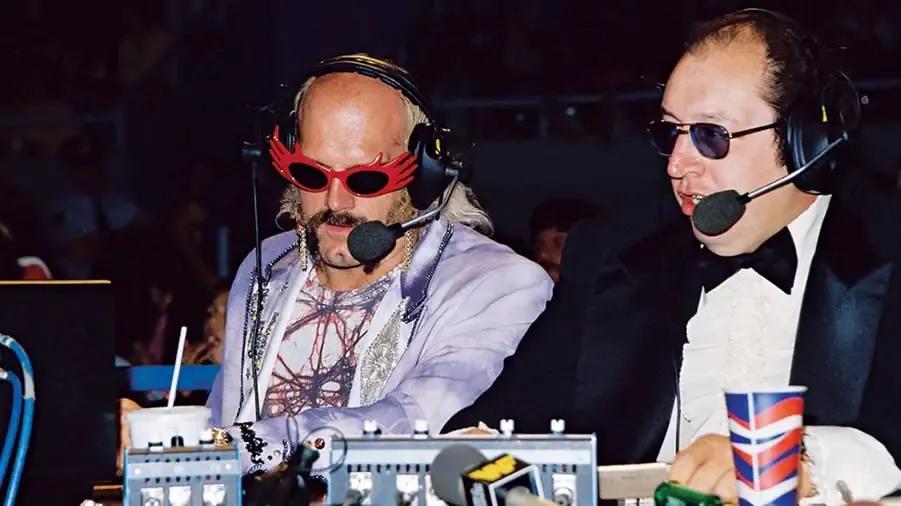
For the third straight year, Survivor Series was called by veteran voices Gorilla Monsoon and Jesse Ventura, who to this point had worked the extreme majority of WWE pay-per-views together. However, SummerSlam in 1989 saw young Tony Schiavone fill in for Monsoon, and do an excellent job working alongside The Body. Schiavone was under the impression that he was calling Survivor Series too, before getting a rude awakening (not the Neckbreaker).
Schiavone recalled on a 2017
What Happened When
episode that while speaking to longtime WWE producer Nelson Sweglar, Sweglar casually mentioned Monsoon doing Survivor Series, which was news to Tony. Bruce Prichard also, per Schiavone's recollection, confirmed it to Schiavone, and seemed surprised that Schiavone didn't know. When Schiavone asked Vince about it, he says that Vince said: "We haven't decided yet." Schiavone said by this time, he figured his play-by-play days in WWE were running out (though he did get to call the 1990 Royal Rumble, prior to his exit that April).
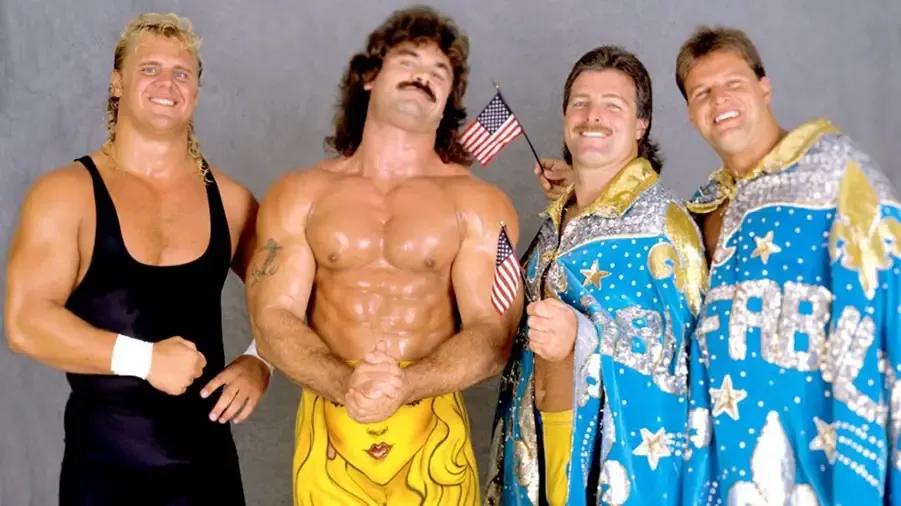
In the
1988 list, I noted the sad reality of Andre the Giant's team, how every member (including both managers) has since passed on save for Harley Race. The 1989 show can be just as depressing if you focus on such matters, as it features another team in which every member but one (Greg Valentine) has passed on. But that's not the only eerie fact.
As of this writing, seven of the 10 team captains on the show are deceased. In order, Andre the Giant, Rick Rude, The Big Boss Man, Macho King Randy Savage, Ultimate Warrior, Dusty Rhodes, and Rowdy Roddy Piper have left this earth. The only living captains are Hulk Hogan, Ted Dibiase, and Hacksaw Jim Duggan, who are each in their mid-sixties today. Over, 15 of the 40 wrestlers on the show (three out of every eight) has died in the interim 29 years.

If I were to tell you that a man who fell off the Hell in a Cell cage in both 2016 and 2017 was visible on camera at the 1989 Survivor Series, would you believe me? Shane McMahon, the man whose grey hair doesn't betray his eternal youth in the slightest, was only 19 years old come the last Thanksgiving of the 1980s, and would play a continual role throughout the night.
Shane had previously acted as a referee in several lower-profile matches, but Survivor Series marked Shane's pay-per-view debut. The son of the Chairman primarily served as an outside referee during the four-on-four matches, dispatching those who had been eliminated from the ringside area as a means of maintaining order. Little did he realize that in another decade, he and Enforcers captain Big Boss Man would become members of a combination evil corporation/Satanic cult. Ahh, wrestling.

If you have the time, fire up Survivor Series 1989 on the award-winning WWE Network and take a listen to Vince McMahon's raging, phlegmy introduction for the teams at the start of the pay-per-view. It is quintessential Vince, screaming the names as though he'd just swallowed a gamma-laced jalapeno pepper. When you listen to that glorious pre-show listen, keep your ears open when he announces The Enforcers' team. Doesn't Bad News Brown's name sound a little louder than the others?
That's because Bad News was a late addition to the show, filling in for Boss Man's usual partner, Akeem. Akeem had been injured a few weeks before the pay-per-view, so Bad News filled in, prompting Vince to have to redub News' name. That wasn't even the most glaring of audio edits in that introduction, but fear not - we'll get to the more obvious one later on.
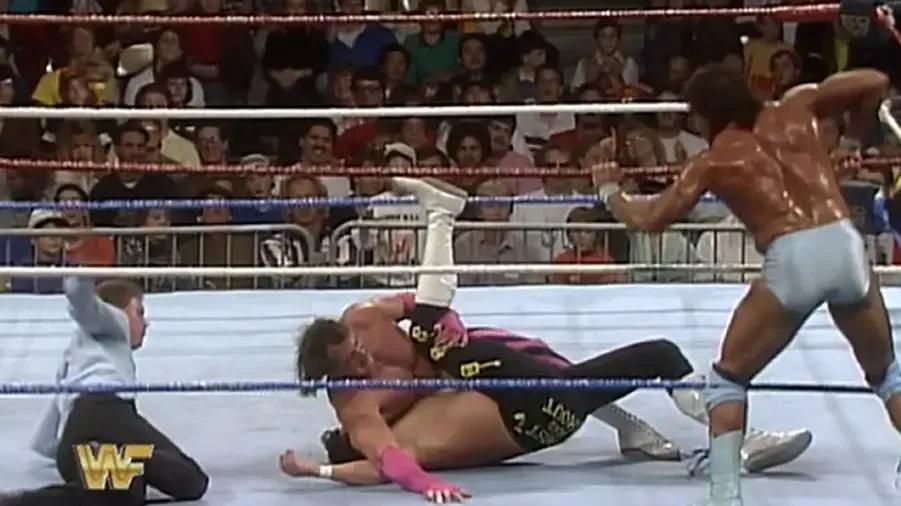
Cosmic coincidence? Careful planning? I'd be more inclined to go with the former when it comes to the first three Survivor Series events and the curious intertwining of Brutus Beefcake and The Honky Tonk Man. The two may have been more known for their 1988 feud over the Intercontinental belt, but their Survivor Series history is worth further examination.
At the three shows from 1987-89, Beefcake and Honky were on opposite sides in each of the opening matches. In 1987, Honky eliminated Beefcake with a Shake, Rattle, and Roll Neckbreaker. A year later, the two brawled at ringside, resulting in a double countout. In 1989, Beefcake brought it to the opposite end of the spectrum when he caused Honky's elimination with a Running High Knee. Does this make them the Sami and KO of their day?

Calling back to that Bad News Brown/Akeem entry, I made reference to another portion of Vince McMahon's overcaffeinated pay-per-view intro where there was a rather obvious edit. Check out when he's announcing the participants in the 4X4s vs. King's Court match, when he goes: "Bret Hart...along with Dino Bravo! Hercules! ANDTHEEARTHQUAKE." It was about as conspicuous as a missing eyeball.
Earthquake, who had only debuted on TV weeks earlier, was a late substitution for the show, filling in for "The Widowmaker" Barry Windham on Randy Savage's team. Windham's personal life was a little troubled at that point. In mid-October, he took time away to have a benign tumor removed from his chest. Additionally, father Blackjack Mulligan and brother Kendall Windham were arrested as part of a counterfeiting ring. Windham bowed out of WWE altogether around this time, before resurfacing in NWA in mid-1990.
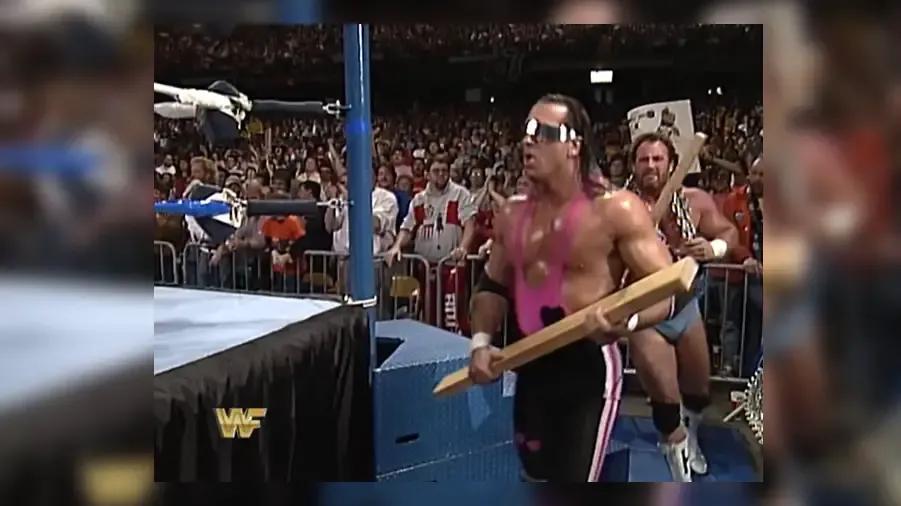
Bret Hart had a respectable showing at the 1989 Survivor Series, lasting deep into his match before being eliminated following a Randy Savage flying elbow smash. It was a pretty good performance from one of WWE's most skilled in-ring competitors, and doubly impressive when you realize that Hart probably shouldn't have been in the ring that night - or for the foreseeable future.
Less than four weeks before the pay-per-view, Bret suffered devastating injuries after crashing chest-first onto a guardrail during a house show match with Dino Bravo in Toronto. As a result of the bad landing, Hart cracked several ribs, fractured his sternum, and bruised his heart. He was told he would likely be out of action for three months or longer, but Hart returned to the road after less than three weeks recuperation, in time to make Survivor Series. He admitted that his ribs would bother him for years after, as a result of returning to the ring early.

Savage ended up surviving in his match alongside partners Dino Bravo and Earthquake, almost pitching a clean sweep if Greg Valentine hadn't been pinned by Jim Duggan. The match served to "keep Savage strong" in building to the No Holds Barred cage match the following month (which was plugged heavily during the show), and it also afforded Savage a unique distinction.
With the win, Macho Man Randy Savage became the first man to survive three times at Survivor Series. In 1987 and 1988, Savage stood tall as a babyface alongside Jake Roberts and Ricky Steamboat at the former event, and with Hulk Hogan at the latter. Savage would only ever again compete in one elimination match, which wouldn't come until 1993. His team won, but Savage was the second man to be eliminated, after being pinned by IRS.
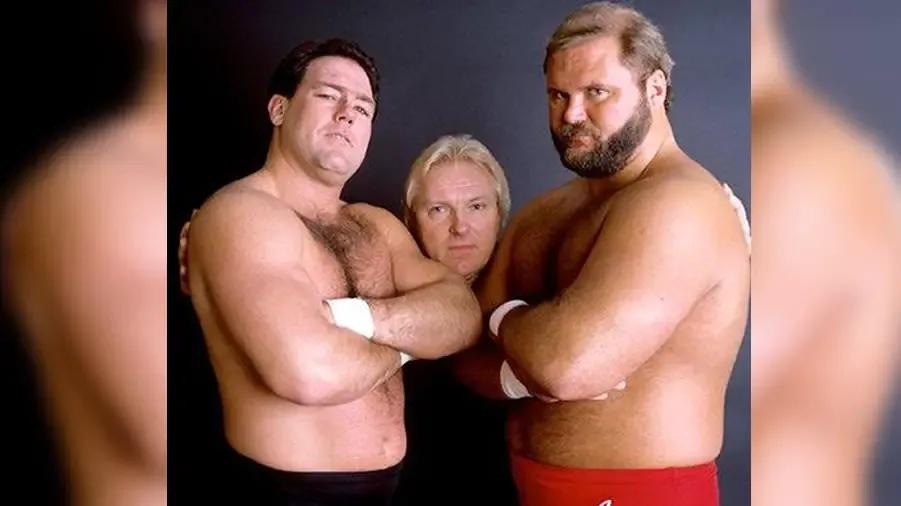
The most interesting substitution on the show came in the main event, when Bobby Heenan stepped into the ring to team with three of his Heenan Family charges, Andre the Giant, Haku, and Arn Anderson. The Brain filled in for Tully Blanchard, and commentator Jesse Ventura indicated that there had been rumblings of friction within the group.
In real life, Blanchard didn't even make it to the show. Some time after SummerSlam, Blanchard and Anderson (while reigning as Tag Team Champions) gave their notice that they would be finishing up with WWE later that fall, before returning to NWA. They dropped the belts back to Demolition shortly after. Anderson finished up after Survivor Series, but Blanchard was fired three weeks prior due to a failed drug test. As a result of the fail, NWA took only Anderson back, leaving Blanchard out in the cold.

In a sign of things to come for WWE's direction in 1990, The Ultimate Warrior stood tall at the end of the night, polishing off Arn Anderson and Bobby Heenan to become his match's sole survivor. In four months' time, Warrior would get to vanquish Hulk Hogan at WrestleMania 6 in order to capture the WWE Championship, and some say that the Warriors-Heenan Family match was a way to test Warrior out as a PPV main eventer.
Whether that's true or not, it marked only the second time a WWE pay-per-view did not feature Hulk Hogan in the final match, either as a wrestler or ringside presence. The first time was the sometimes-forgotten Wrestling Classic in 1985, in which Junkyard Dog defeated Randy Savage in a tournament final. Though his World title run would ultimately (pun not intended) prove less than stellar, Warrior's frenetic theme music did fit well over a pay-per-view fading to black.